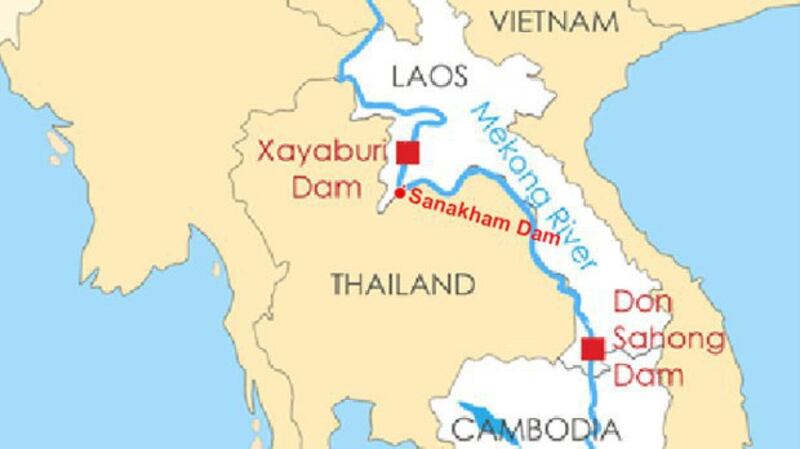A hydropower project set to be built in Laos is raising concerns in next-door Thailand, with government officials and environmental experts voicing alarm over forced relocations, impacts on fish stocks and security along the two countries’ shared border.
Speaking on Dec. 17 at a seminar in Chiang Khan in northeastern Thailand, participants said the China-backed Sanakham Dam — now moving ahead after a two-year delay amid COVID-19 concerns — will force many Lao villagers from their homes.
“This will put their health and livelihoods at risk,” said Piraton Bunyaratpan, a social economic expert from Thailand’s Naresuan University who said he had examined information about the dam forwarded by the project’s developer.
“Of course, the severe impacts will occur in Laos. The impacts may be less serious in nearby countries,” he said. “The project developer has said nothing so far about compensation” paid to villagers forced to relocate, he added.
Developers have also not shared data on the project’s impact on fish stocks along the affected stretch of the Mekong River, said Thuanthong Jutaket, a fishery expert from Thailand’s Ubon Rachatany University.
“Most fish live around rocks and rapids and in the deep waters of the Mekong River, so if this dam is built and the EIA [environmental impact assessment] is not properly done, there will be a big loss of the fishes’ habitat,” he said.
According to an initial impact assessment, the Sanakham Dam—a $2 billion project with capacity to produce 684 megawatts of electricity—will be built on the Mekong River between the Kentao district of Xayaburi province and the Sanakham district of Vientiane province, and will uproot three villages, displacing 1,127 residents in 267 families.
Developers of the project, which will sell power mainly to Thailand when operation begins, are the Datang Lao Sanakham Hydropower Company, an affiliate of Datang International Power Generation of China.
Border security concerns
Participants in the Thai conference also raised concerns that smuggling and other cross-border movements will be made easier by the dam’s operation, affecting Thailand’s national security.
“After the dam is built, the water levels will be low, and our patrol boats might get stuck,” said Captain Nirud Matong, an officer of the Thai Mekong River Patrol Forces in Nonkhai province. “And the locals who live near the river will be able to just walk across to the other side.”
“Therefore, the dam will impact not only people’s livelihoods but also the border and other islands in the river too,” he said.
Tarit Thanaphatnophon, head of the security department of Chiang Kan district in Loei province, worried that the dam’s operations will affect the bilateral relationship between Laos and Thailand, noting that Loei province lies adjacent to Xayaburi and Vientiane in Laos.
“So, if the dam is built, this will affect all three provinces,” he said. “As the head of security for my district, I feel it’s very necessary for us to have a good relationship with the authorities of Sanakham district in Vientiane and Kentan district in Xayaburi.”

Calls for work to stop
Also attending the conference, members of Thai NGOs called on developers and the Lao government to stop work on the dam pending assurances the project will not have negative impacts on Thailand’s side of the river.
“The information we have received is not sufficient,” a member of the Thai People’s Network of the Lower Mekong River said, asking for anonymity in order to speak freely.
“The dam will create severe impacts reducing fisheries. The big fish will disappear, and the livelihoods of our fishermen and farmers will be wiped out,” he said. “How will the dam’s developers create jobs for the fishermen and farmers?”
Lao villagers and others living along the Mekong should also be included in discussions, a representative of the Mekong River Network of Loei Province said. “We’re talking only among ourselves here, and that’s not right.”
“We should invite people from our neighboring countries to join us so that together we can exchange information and act to protect our interests and create sustainable development,” he said.
Surasi Kittimonton, secretary of the Office of Thai National Water Resources, told the conference that the information now available about the Sanakham dam was forwarded to Thailand in 2019 and is now out of date.
“We’ve checked the information — especially the information about the environmental impact assessment — and I can attest that the information we’ve received is incomplete and is unclear in many areas.”
“We’ve asked that more information be sent to us,” he said.
Laos has built dozens of hydropower dams on the Mekong and its tributaries and is building about 50 more under a plan to become the “Battery of Southeast Asia” and export the electricity they generate to other countries in the region, mainly Thailand.
The Lao government sees power generation as a way to boost the country’s economy, but the dam projects are controversial because of their displacement of villagers without adequate compensation, environmental impact, and questionable financial and power demand arrangements.
Reported and translated by Max Avary for RFA’s Lao Service. Written in English by Richard Finney.
